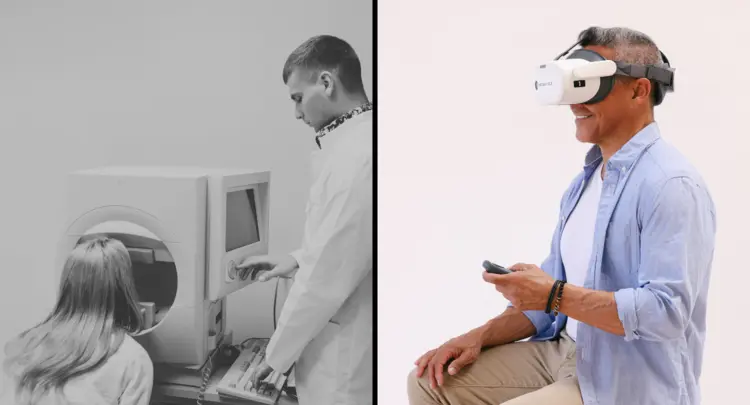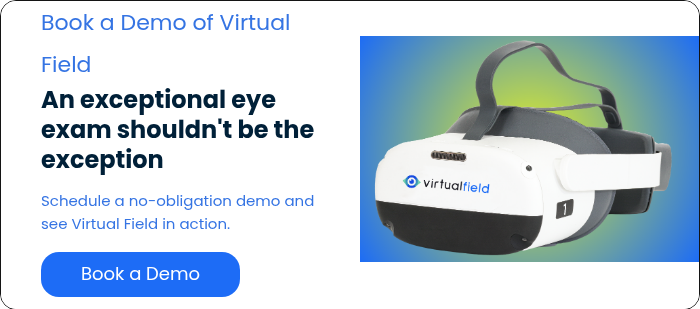The idea that our world might become dim one day, graying at the edges, losing clarity and vibrancy, is a terrifying concept. Yet for cataract patients, it’s an all too real and all too painful reality.
Cataracts are a leading cause of vision impairment worldwide, and a continual patient complaint for eye doctors across the country.
As vision care providers, accurately assessing visual function in cataract patients is crucial for diagnosis, treatment planning, and managing patient expectations. For cataract patients, selecting the most insightful test modality is critical due to the lens opacities that can compromise the accuracy of results.
Standard Automated Perimetry (SAP) and Virtual Reality (VR) Kinetic Perimetry are two approaches worth evaluating.
What is Visual Field Testing?
Visual field testing assesses the full scope of a patient’s vision, both central and peripheral. It helps identify defects or sensitivities in the visual field, which may indicate underlying conditions. In cataract patients, testing must account for the impact of lens opacities while still providing actionable diagnostic data.
Standard Automated Perimetry (SAP) Modalities
SAP is a traditional method for visual field testing in modern ophthalmology and optometry. It utilizes automated machines to present static light stimuli of varying intensities at predetermined locations within the visual field. The patient responds when they perceive the stimulus, and the machine generates a map of their visual sensitivity.
Strengths of SAP:
- Standardization: SAP offers standardized testing procedures, ensuring consistency.
- Quantitative Data: It provides precise data, including metrics like Mean Deviation (MD) and Pattern Standard Deviation (PSD).
- Efficiency: Automated testing allows for relatively quick assessments.
- Sensitivity: SAP is sensitive to detecting subtle central visual field defects.
Limitations of SAP for Cataract Patients:
- Cognitive Demands: SAP requires sustained attention, which can be challenging for older patients and those with cognitive disabilities.
- Fatigue: The static nature can induce fatigue, impacting reliability.
- Limited Real-World Relevance: Static stimuli may not fully reflect real-world visual function.
- Susceptibility to Cataract Effects: Lens opacities caused by cataracts can diffuse light stimuli, leading to false negatives or reduced accuracy.
- Static Testing Limitations: By focusing on fixed points, SAP may miss certain functional aspects of vision, like tracking moving objects.
Kinetic Perimetry with a Virtual Reality Visual Field Device
Virtual reality-based kinetic perimetry testing leverages immersive virtual reality technology combined with kinetic perimetry principles. Patients wear a headset that presents dynamic, moving stimuli of varying sizes and brightness across the visual field. They indicate when they first perceive the stimuli, allowing clinicians to map boundaries of the visual field.
Strengths of VR Kinetic Perimetry:
- Flexibility: VR Kinetic perimetry offers flexibility in stimulus presentation and interaction, allowing for adaptation to individual patient needs.
- Potentially Reduced Cognitive Load: The dynamic nature of the test may be less demanding on sustained attention compared to static SAP for some individuals.
- Enhanced Visual Engagement: VR can provide a more engaging and intuitive visual experience, potentially beneficial for cataract patients.
- Comfort Considerations: VR setups are designed with patient comfort in mind, which can be an important factor in testing.
- Dynamic Assessment: Kinetic stimuli allow for the assessment of both peripheral and central vision, including evaluation of motion detection.
- Addressing Cataract Effects: VR kinetic perimetry systems can often utilize high-contrast stimuli and adaptable environments, which may help in mitigating the effects of cataracts on stimulus perception.
Limitations for VR Kinetic Perimetry:
- The Need to Rebaseline Patients: While VR-based kinetic testing improves upon traditional Goldmann modalities and may correlate to SAP data algorithms, there may still be differences in data interpretation that require rebaselining patients previously tested using SAP.
- Potential for Motion Sickness: As with any VR experience, some patients may experience motion sickness, though this can often be managed.
Choosing the Right Test for Cataract Patients
The optimal choice of visual field testing method for cataract patients depends on several factors:
- Patient's Cognitive Status: VR kinetic perimetry can be a valuable option for patients with difficulty with sustained attention.
- Patient's Physical Limitations: The comfort and flexibility of VR testing can be advantageous for patients with mobility issues.
- Cataract Density: The density and type of cataract can influence SAP and kinetic perimetry results, requiring careful interpretation.
- Clinical Objectives: SAP remains a valuable tool when precise quantitative data is essential for tracking disease progression (e.g., in patients with coexisting glaucoma).
- Comprehensive Care: VR modalities can offer advantages in comprehensive assessment, enabling the integration of various tests within a single visit and on the same device. Integrated testing (e.g., with pupillometry) is an example of the comprehensive capabilities of a VR testing solution.
Comparing SAP to VR Kinetic Perimetry
In Summary
Generally, SAP is a well-established and valuable tool for detecting subtle visual field changes, particularly in early-stage diseases or conditions like glaucoma. VR kinetic perimetry offers a complementary and evolving approach, with potential benefits for patient comfort, dynamic assessment, and addressing the challenges posed by cataracts.
Ultimately, when selecting a testing method for cataract patients, the choice should be tailored to the individual patient's needs and the specific clinical objectives.
Virtual Field's comprehensive virtual reality visual field solution offers a range of exam types in a patient-friendly headset with automated instructions in over 40 languages, providing a valuable tool for practices of every size in their comprehensive cataract care.
About Virtual Field
Virtual Field delivers an exceptional eye exam experience. Eye care professionals including ophthalmologists and optometrists examine patients faster, more efficiently, and more comfortably than ever before. Exams include Visual Field, 24-2, Kinetic Visual Field (Goldmann Perimetry), Ptosis, Esterman, Color Vision, Pupillometry, Extraocular Motility (EOM), and more.


